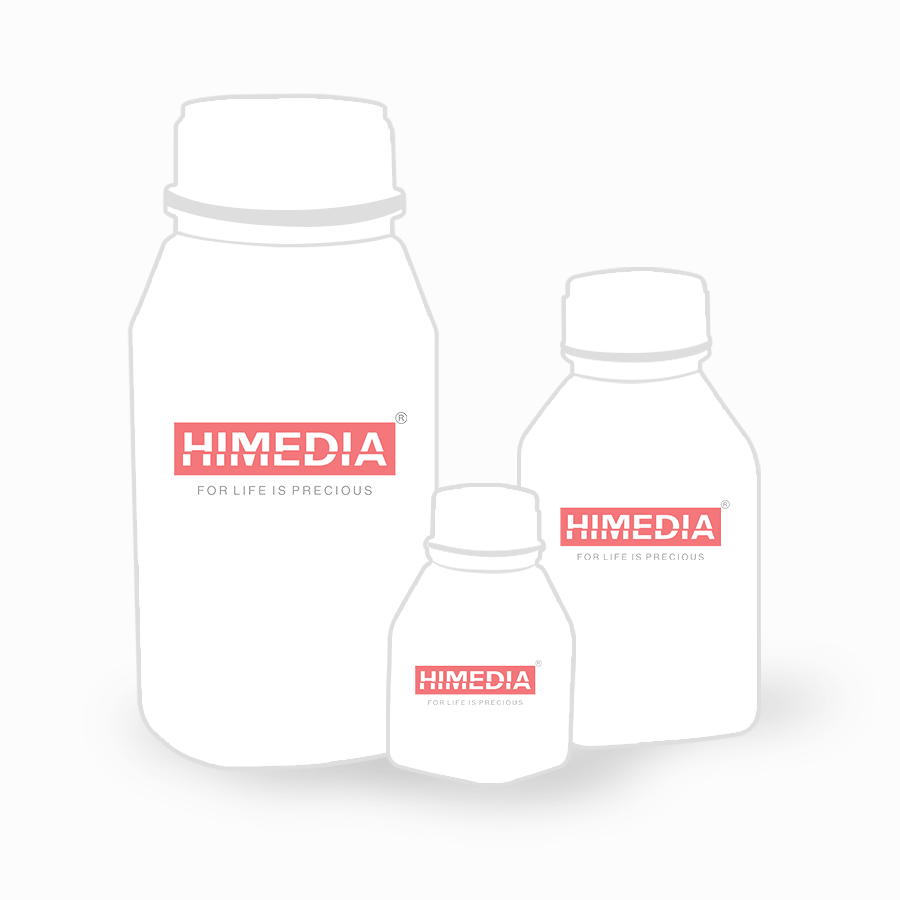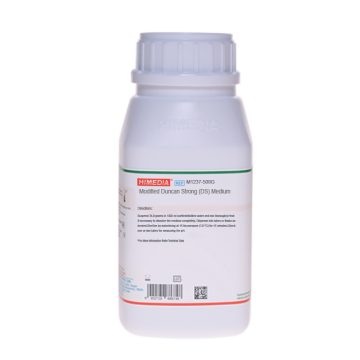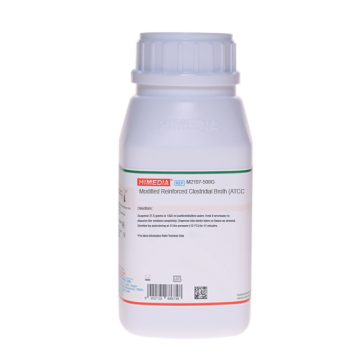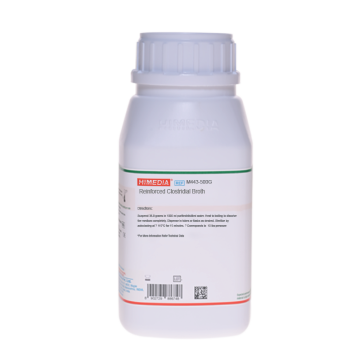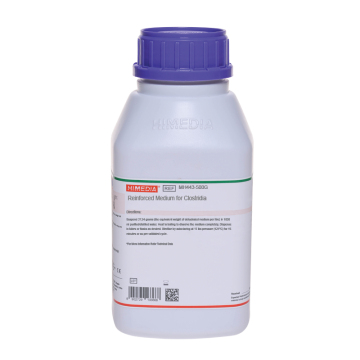 Your enquiry has been submitted
Your enquiry has been submitted
Modified Differential Clostridial Broth
Intended Use:
Recommended for enumeration of Clostridia from food stuffs and other samples by the MPN technique.
Composition**
| Ingredients | Gms / Litre |
|---|---|
| Tryptone | 5.000 |
| HM peptone # | 5.000 |
| HM extract $ | 8.000 |
| Yeast extract | 1.000 |
| Starch | 1.000 |
| Dextrose (Glucose) | 1.000 |
| L-Cysteine hydrochloride | 0.500 |
| Sodium acetate | 5.000 |
| Sodium bisulphite | 0.500 |
| Ammonium ferric citrate | 0.500 |
| Resazurin sodium | 0.002 |
Final pH (at 25°C): 7.1±0.2
**Formula adjusted, standardized to suit performance parameters
# Equivalent to Meat peptone
$ Equivalent to Meat extract
Directions
Suspend 27.5 grams in 1000 ml distilled water. Heat if necessary to dissolve the medium completely. Dispense in tubes or flasks as desired. Sterilize by autoclaving at 15 lbs pressure (121°C) for 15 minutes.
Principle And Interpretation
Clostridium perfringens is a normal inhabitant of the intestine. Although present in smaller numbers compared to E.coli, its spores can survive in water for long periods and persist when all other faecal bacteria have died. An examination for their presence in water is valuable in demonstrating remote or intermittent pollution and in confirming the presence of faecal contamination when only coliforms other than E. coli are cultured from water (1).
Modified Differential Clostridial Broth was developed for the enumeration of spores of sulphate reducing Clostridia in dried foods (3,10,11). This medium is a modification of the media devised by Hirsch and Grinsted (5) and Gibbs and Hirsch (4) and is used for the enumeration of Clostridia from food stuffs and other samples by MPN technique. It is differential by means of detecting the ability of organisms to reduce sulphite to sulphide and thereby form iron sulphide, a black coloured complex. This medium is non-selective as other bacteria can also produce sulphide. Therefore, to enumerate Clostridia, pasteurization must be done to remove the vegetative cells.
Modified Differential Clostridial Broth has ingredients like Tryptone, yeast extract, HM peptone and HM extract which provide nitrogen, carbon sources, essential nutrients and growth factors to the organisms. Starch also neutralizes toxic metabolites. This nutritionally rich composition promotes spore germination. Dextrose is the fermentable carbohydrate and serves as carbon and energy source. L-Cysteine hydrochloride acts as reducing agent. Sodium bisulphite and ferric ammonium citrate form indicator system for sulphite reduction. Resazurin is a redox indicator, which helps in detection of anaerobiosis, in the medium. Antibiotics like polymyxin B can be added to the medium to inhibit non-spore formers (3). Clostridia can be identified directly in this broth as they produce a black colouration, which is unlikely in Reinforced Clostridial Medium (M443) (8).
In order to facilitate spore germination, a heat treatment of the spores/samples at 80°C for 10 minutes may be given before inoculation (2).
Type of specimen
Food sample.
Specimen Collection and Handling
For food samples, follow appropriate techniques for sample collection and processing as per guidelines (9).
After use, contaminated materials must be sterilized by autoclaving before discarding.
Warning and Precautions
Limitations
- Morphological, biochemical and/or serological tests should be performed for final identification.
- Individual organisms differ in their growth requirement and may show variable growth patterns on the medium.
- Each lot of the medium has been tested for the organisms specified on the COA. It is recommended to users to validate the medium for any specific microorganism other than mentioned in the COA based on the user's unique requirement.
Performance and Evaluation
Performance of the medium is expected when used as per the direction on the label within the expiry period when stored at recommended temperature.
Quality Control
Appearance: Cream to yellow homogeneous free flowing powder
Colour and Clarity of prepared medium: Yellow coloured clear to slightly opalescent solution that becomes red due to aeration on standing
Reaction: Reaction of 2.75% w/v aqueous solution at 25°C. pH: 7.1±0.2
pH: 6.90-7.30
Cultural Response
Cultural characteristics observed under anaerobic condition after an incubation at 35-37°C for 18-48 hours.
| Organism | Inoculum (CFU) | Growth | H2S production |
|---|---|---|---|
| Clostridium perfringens ATCC 12924 | 50-100 | luxuriant | positive reaction, blackening of medium |
| Clostridium sporogenes ATCC 11437 | 50-100 | luxuriant | positive reaction, blackening of medium |
Storage and Shelf Life
Store between 10-30°C in a tightly closed container and the prepared medium at 15-25°C. Use before expiry date on the label. On opening, product should be properly stored dry, after tightly capping the bottle inorder to prevent lump formation due to the hygroscopic nature of the product. Improper storage of the product may lead to lump formation. Store in dry ventilated area protected from extremes of temperature and sources of ignition Seal the container tightly after use. Product performance is best if used within stated expiry period.
Disposal
User must ensure safe disposal by autoclaving and/or incineration of used or unusable preparations of this product. Follow established laboratory procedures in disposing of infectious materials and material that comes into contact with sample must be decontaminated and disposed of in accordance with current laboratory techniques (6,7).
Reference
- Collee J. G., Fraser A. G., Marmion B. P., Simmons A., (Eds.), Mackie and McCartney, Practical Medical Microbiology, 1996, 14th Edition, Churchill Livingstone.
- Corry J. E. L., Curtis G. D. W. and Baird R. M., Culture Media for Food Microbiology, Vol. 34, Progress in Industrial Microbiology, 1995, El sevier, Amsterdam.
- Gibbs B. M. and Freame B., 1965, J. Appl. Bacteriol., 28(1):9
- Gibbs B. M. and Hirsch A., 1956, J. Appl. Bacteriol., 19:12.
- Hirsch A. and Grinsted E., 1954, J. Dairy Res., 21 : 10.
- Isenberg, H.D. Clinical Microbiology Procedures Handbook 2nd Edition.
- Jorgensen, J.H., Pfaller, M.A., Carroll, K.C., Funke, G., Landry, M.L., Richter, S.S and Warnock., D.W. (2015) Manual of Clinical Microbiology, 11th Edition. Vol. 1.
- MacFaddin J. F., 1985, Media for Isolation-Cultivation-Identification-Maintenance of Medical Bacteria, Vol. 1, Williams and Wilkins, Baltimore.
- Salfinger Y., and Tortorello M.L. Fifth (Ed.), 2015, Compendium of Methods for the Microbiological Examination of Foods, 5th Ed., American Public Health Association, Washington, D.C.
- Weenk G., Fitzmaurice E., and Mossel, D. A. A.,1991, J. Appl. Bacteriol., 70, 135-143.
- Weenk G. H., Van den Brink J. A., Struijk C. B. and Mossel, D. A. A., 1995, Int. J. Food Microbiol., In press, 27:185.
| Product Name | Modified Differential Clostridial Broth |
|---|---|
| SKU | M1085 |
| Product Type | Regular |
| Physical Form | Powder |
| Origin | Animal |
| Packaging type | HDPE |
| References | 1. Collee J. G., Fraser A. G., Marmion B. P., Simmons A., (Eds.), Mackie and McCartney, Practical Medical Microbiology,1996, 14th Edition, Churchill Livingstone. |
| Customized Product Available | No |



